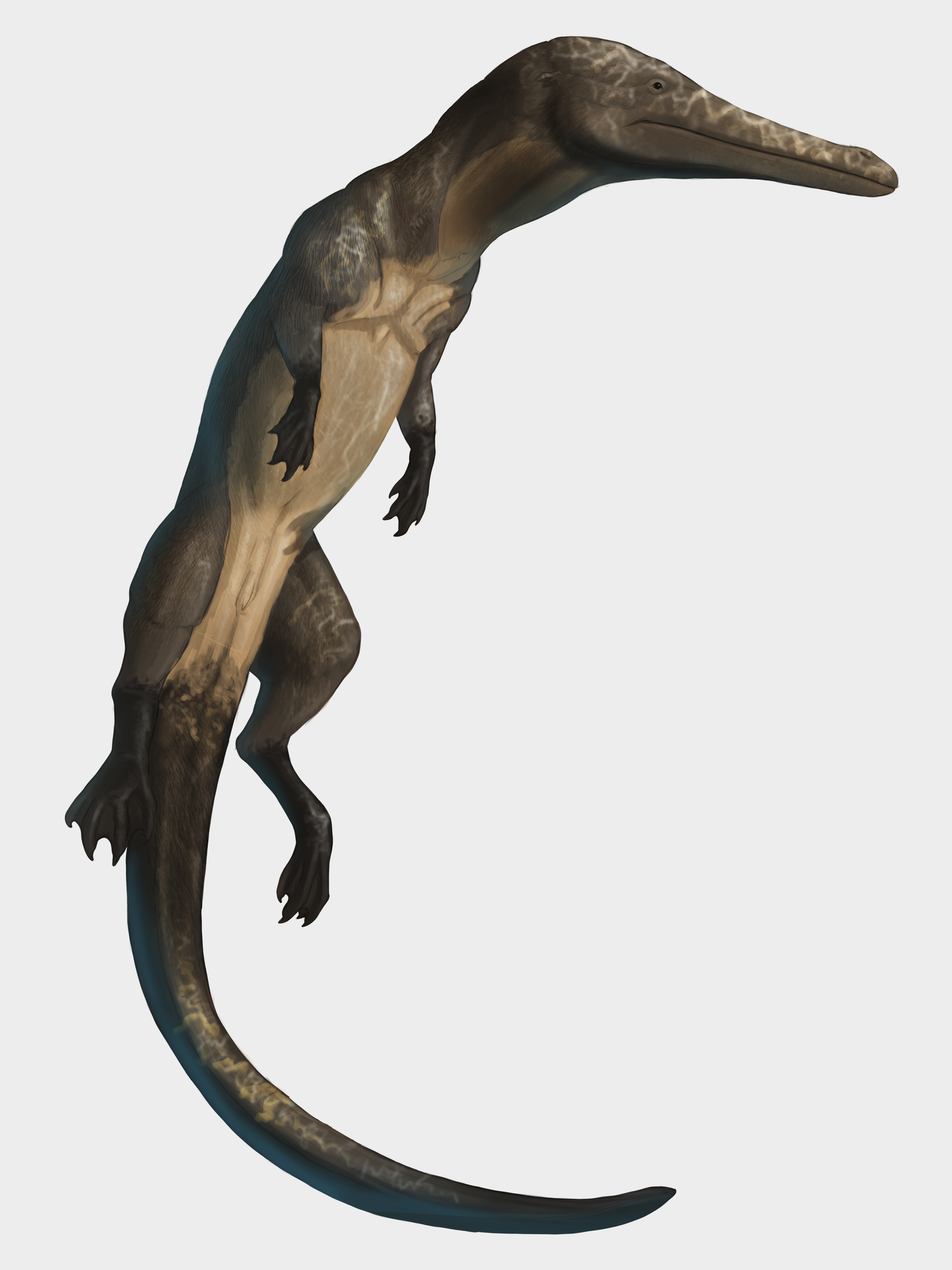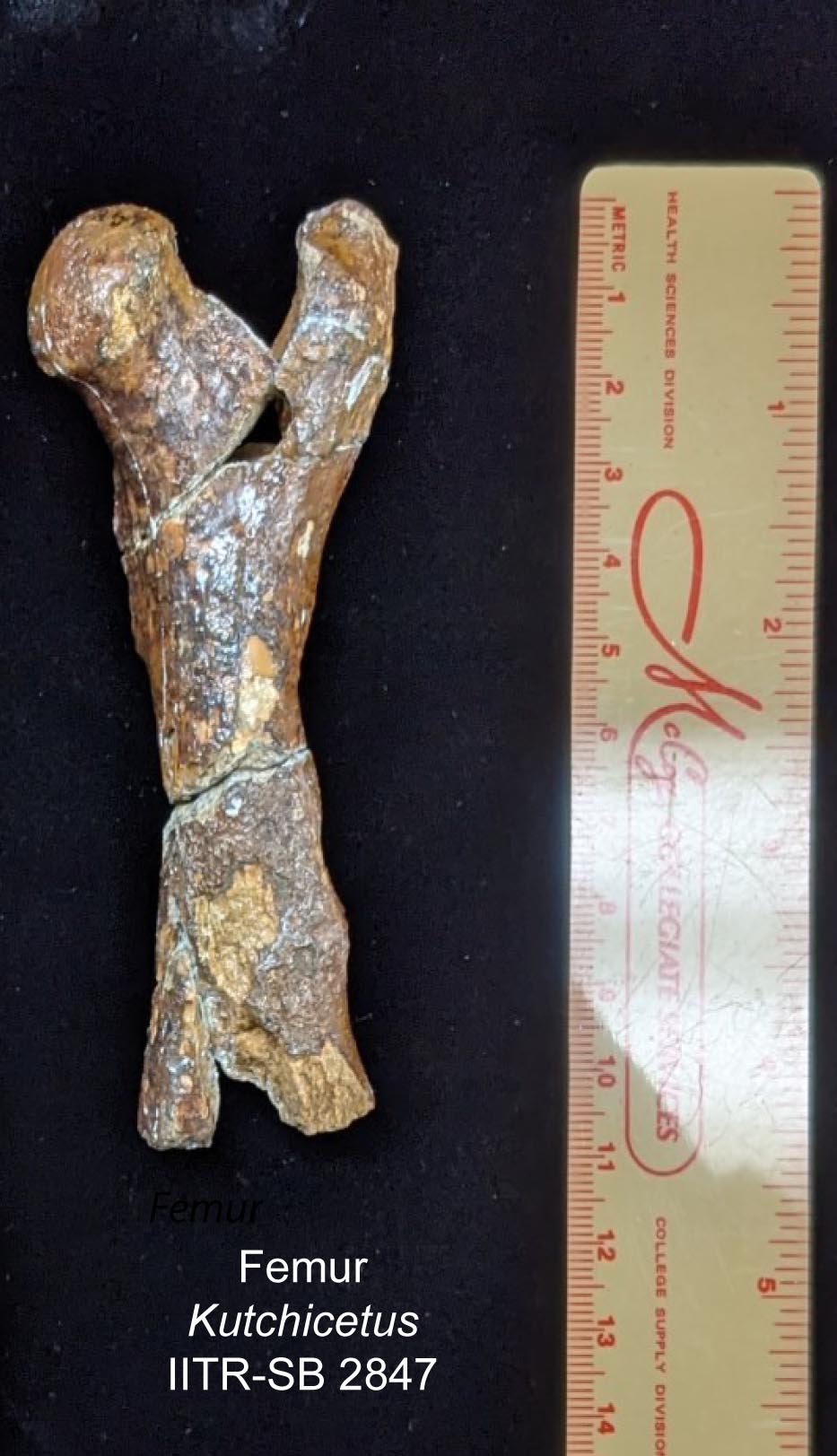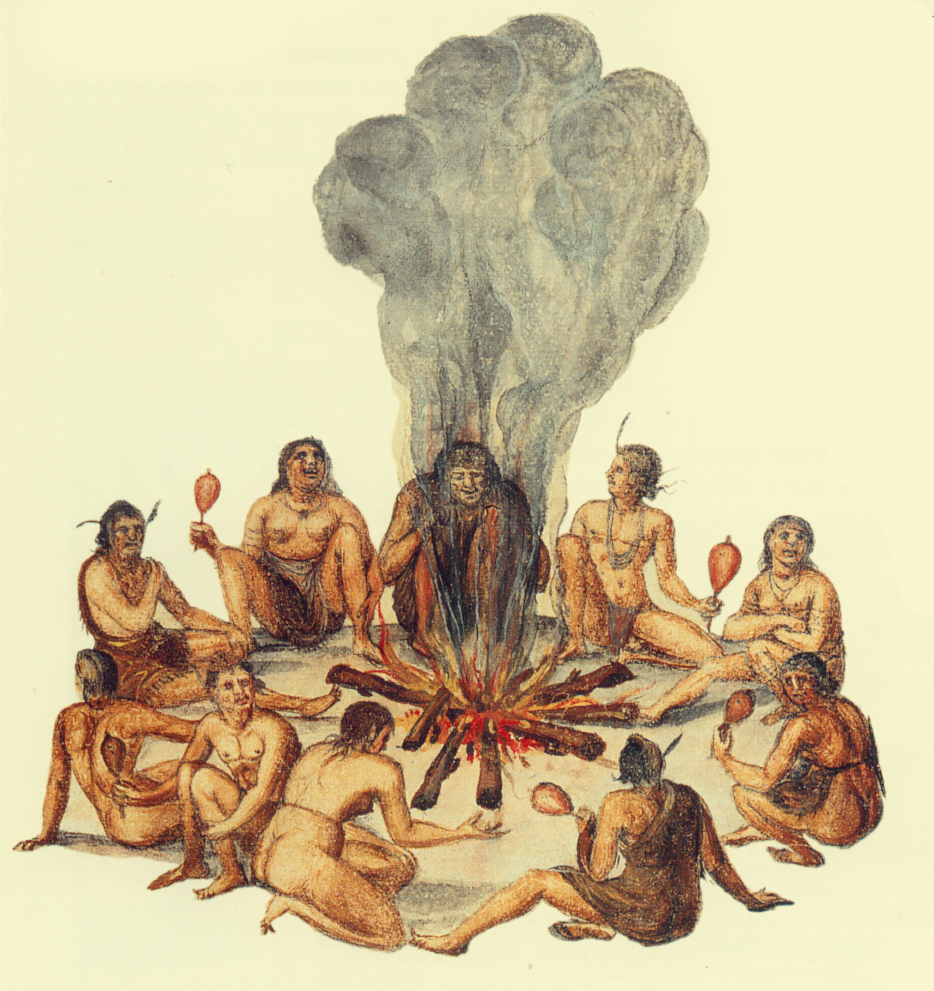|
Remingtonocetidae
Remingtonocetidae is a diverse family of early aquatic mammals of the order Cetacea. The family is named after paleocetologist Remington Kellogg. Description Remingtonocetids have long and narrow skulls with the external nare openings located on the front of the skull. Their frontal shields are narrow and their orbits small. Their mouth has a convex palate and an incompletely fused mandibular symphysis. The dental formula is . The anterior teeth are flattened mediolaterally, making them appear shark-like. In the postcranial skeleton, the cervical vertebrae are relatively long and the sacrum is composed of four vertebrae of which at least three are fused. The acetabular notch is narrow or closed and on the femoral head the fovea is absent. Cranial fossils are common but dental remains are rare. The postcrania morphology is based entirely on a single specimen of '' Kutchicetus'' which was small and had a long and muscular back and tail. Perhaps remintonocetids swam like ... [...More Info...] [...Related Items...] OR: [Wikipedia] [Google] [Baidu] |
Dalanistes
''Dalanistes'' is an extinct genus of Remingtonocetidae, remingtonocetid Archaeoceti, early whale known from the late-early Eocene (Lutetian, ) of Kutch, India and Punjab, Pakistan, Punjab and Balochistan, Pakistan. ''Dalanistes'' is closely related to ''Remingtonocetus'' (the type genus of Remingtonocetidae, a slightly more derived family of early whales), but also shares several features with ''Ambulocetus'' (the type of Ambulocetidae, earlier more primitive whales), and, with its combination of terrestrial and amphibious adaptations, ''Dalanistes'' apparently is an intermediate form between these two groups. Isotopic evidence suggest that ''Dalanistes'' had a marine diet. ''Dalanistes'' is known from several localities and collections. The holotype is a skull and a postcranial skeleton. Additional fossils referred to ''Dalanistes'' include crania, several vertebrae and sacra, possible caudals, one side of the pelvis, and a distal femur. The Dental alveolus, alveoli is all tha ... [...More Info...] [...Related Items...] OR: [Wikipedia] [Google] [Baidu] |
Remingtonocetus
''Remingtonocetus'' is an extinct genus of early cetacean freshwater aquatic mammals of the family (biology), family Remingtonocetidae endemic to the coastline of the ancient Tethys Ocean during the Eocene. It was named after naturalist Remington Kellogg. History of discovery named ''Protocetus harudiensis'' based on a partial skeleton, the type specimen found in the Lutetian shallow subtidal mudstone in the Harudi Formation, India. renamed it ''Remingtononocetus harudiensis'' due to morphological differences from ''Protocetus''. ''Remingtonocetus domandaensis'' was named by based on a partial skeleton found in a Lutetian coastal shale in the Domanda Formation of Pakistan. ''Remingtonocetus'' is larger, has a broader Rostrum (anatomy), rostrum, and longer premolars than ''Andrewsiphius''. It is smaller than, has more gracile premolars and molars than ''Dalanistes''. ''R. harudiensis'' differs from ''R. domandaensis'' in molar morphology. Description ''Remingtonocetus'' was ... [...More Info...] [...Related Items...] OR: [Wikipedia] [Google] [Baidu] |
Kutchicetus
''Kutchicetus'' is an extinct genus of early whale of the family Remingtonocetidae that lived during Early-Middle Eocene (Lutetian and Ypresian) in what is now the coastal border of Pakistan and India (, paleocoordinates ). It is closely related to ''Andrewsiphius'' with which it was synonymized by . proposed a new clade, Andrewsiphiinae, for the two species. Later authors, however, still accept both as separate genera. ''Kutchicetus'' is smaller than other remingtonocetids, and probably is the smallest Eocene cetacean. With its extremely narrow snout, it resembles ''Remingtonocetus'' and '' Dalanistes'', but its strong tail distinguishes it from both ''Remingtonocetus'' and ''Andrewsiphius''. Its limbs were short. ''Kutchicetus''' vertebral formula is 7, 15, 8, 4, 20–25. Its four fused sacral vertebrae were probably articulated to the hip bone and the numerous tail vertebrae were robust and elongated in contrast to its short and relatively gracile limb bones. This m ... [...More Info...] [...Related Items...] OR: [Wikipedia] [Google] [Baidu] |
Castle Hayne Limestone
The Castle Hayne Limestone (also called the Castle Hayne Formation) is a middle Eocene-aged Formation (geology), geologic formation in North Carolina, USA. It consists of cobble to pebble sized clastic rocks, clasts, usually rounded, coated with phosphate and glauconite in a limestone matrix. The formation has been dated to the middle Eocene, but its exact age remains uncertain; however, it is generally thought to date to the Lutetian or early Bartonian. Description The Castle Hayne Formation is divided into three submembers: the New Hanover member, the Comfort Member, and the Spring Garden Member. The New Hanover member is the oldest member and is characterizes by cobbles and pebbles, fine sand, glauconite, and phosphate in a fine limestone matrix. The most common fossils are shark and ray teeth. Index fossils place this member in the middle Eocene. The Comfort member lies above the New Hanover member. It contains bryozoa and sea urchin fossils and beds of glauconite and phosp ... [...More Info...] [...Related Items...] OR: [Wikipedia] [Google] [Baidu] |
Rayanistes
''Rayanistes'' is a genus of remingtonocetid whale from the Middle Eocene deposits in Egypt. Significance and biology ''Rayanistes'' was capable of extensive power strokes during pelvic paddling, based on the robust hindlimb and innominate. The more abducted orientation of its femur allowed for greater maneuverability of the hip joint in contrast to that of ''Remingtonocetus ''Remingtonocetus'' is an extinct genus of early cetacean freshwater aquatic mammals of the family (biology), family Remingtonocetidae endemic to the coastline of the ancient Tethys Ocean during the Eocene. It was named after naturalist Remington ...''. The discovery of ''Rayanistes'' is significant because it shows that the most primitive non-pelagicete cetaceans were becoming widespread beyond the southern margin of the ancient Tethys sea.Ryan M. Bebej, Iyad S. Zalmout, Ahmed A. Abed El-Aziz, Mohammed Sameh M. Antar and Philip D. Gingerich (2016). "First remingtonocetid archaeocete (Mammalia, Cetacea) f ... [...More Info...] [...Related Items...] OR: [Wikipedia] [Google] [Baidu] |
Cetacea
Cetacea (; , ) is an infraorder of aquatic mammals belonging to the order Artiodactyla that includes whales, dolphins and porpoises. Key characteristics are their fully aquatic lifestyle, streamlined body shape, often large size and exclusively carnivorous diet. They propel themselves through the water with powerful up-and-down movements of their tail, which ends in a paddle-like fluke, using their flipper-shaped forelimbs to steer. While the majority of cetaceans live in marine environments, a small number reside solely in brackish water, brackish or fresh water. Having a cosmopolitan distribution, they can be found in some rivers and all of Earth's oceans, and many species migrate throughout vast ranges with the changing of the seasons. Cetaceans are famous for cetacean intelligence, their high intelligence, complex social behaviour, and the enormous size of some of the group's members. For example, the blue whale reaches a maximum confirmed length of and a weight of 173 tonne ... [...More Info...] [...Related Items...] OR: [Wikipedia] [Google] [Baidu] |
Ambulocetus
''Ambulocetus'' (Latin ''ambulare'' "to walk" + ''cetus'' "whale") is a genus of early Semiaquatic, amphibious cetacean from the Kuldana Formation in Pakistan, roughly 48 or 47 million years ago during the Early Eocene (Lutetian). It contains one species, ''Ambulocetus natans'' (Latin ''natans'' "swimming"), known solely from a near-complete skeleton. ''Ambulocetus'' is among the best-studied of Eocene cetaceans, and serves as an instrumental find in the study of evolution of cetaceans, cetacean evolution and their transition from land to sea, as it was the first cetacean discovered to preserve a suite of adaptations consistent with an amphibious lifestyle. ''Ambulocetus'' is classified in the group Archaeoceti—the ancient forerunners of modern cetaceans whose members span the transition from land to sea—and in the family (biology), family Ambulocetidae, which includes ''Himalayacetus'' and ''Gandakasia'' (also from the Eocene of the Indian subcontinent). ''Ambulocetus'' ha ... [...More Info...] [...Related Items...] OR: [Wikipedia] [Google] [Baidu] |
Kutchicetus Minimus
''Kutchicetus'' is an extinct genus of early whale of the family Remingtonocetidae that lived during Early-Middle Eocene (Lutetian and Ypresian) in what is now the coastal border of Pakistan and India (, paleocoordinates ). It is closely related to ''Andrewsiphius'' with which it was synonymized by . proposed a new clade, Andrewsiphiinae, for the two species. Later authors, however, still accept both as separate genera. ''Kutchicetus'' is smaller than other remingtonocetids, and probably is the smallest Eocene cetacean. With its extremely narrow snout, it resembles ''Remingtonocetus'' and ''Dalanistes'', but its strong tail distinguishes it from both ''Remingtonocetus'' and ''Andrewsiphius''. Its limbs were short. ''Kutchicetus''' vertebral formula is 7, 15, 8, 4, 20–25. Its four fused sacral vertebrae were probably articulated to the hip bone and the numerous tail vertebrae were robust and elongated in contrast to its short and relatively gracile limb bones. This mo ... [...More Info...] [...Related Items...] OR: [Wikipedia] [Google] [Baidu] |
Atlantic Ocean
The Atlantic Ocean is the second largest of the world's five borders of the oceans, oceanic divisions, with an area of about . It covers approximately 17% of Earth#Surface, Earth's surface and about 24% of its water surface area. During the Age of Discovery, it was known for separating the New World of the Americas (North America and South America) from the Old World of Afro-Eurasia (Africa, Asia, and Europe). Through its separation of Afro-Eurasia from the Americas, the Atlantic Ocean has played a central role in the development of human society, globalization, and the histories of many nations. While the Norse colonization of North America, Norse were the first known humans to cross the Atlantic, it was the expedition of Christopher Columbus in 1492 that proved to be the most consequential. Columbus's expedition ushered in an Age of Discovery, age of exploration and colonization of the Americas by European powers, most notably Portuguese Empire, Portugal, Spanish Empire, Sp ... [...More Info...] [...Related Items...] OR: [Wikipedia] [Google] [Baidu] |
North Carolina
North Carolina ( ) is a U.S. state, state in the Southeastern United States, Southeastern region of the United States. It is bordered by Virginia to the north, the Atlantic Ocean to the east, South Carolina to the south, Georgia (U.S. state), Georgia to the southwest, and Tennessee to the west. The state is the List of U.S. states and territories by area, 28th-largest and List of U.S. states and territories by population, 9th-most populous of the List of states and territories of the United States, United States. Along with South Carolina, it makes up the Carolinas region of the East Coast of the United States, East Coast. At the 2020 United States census, 2020 census, the state had a population of 10,439,388. Raleigh, North Carolina, Raleigh is the state's List of capitals in the United States, capital and Charlotte, North Carolina, Charlotte is its List of municipalities in North Carolina, most populous and one of the fastest growing cities in the United States. The Charl ... [...More Info...] [...Related Items...] OR: [Wikipedia] [Google] [Baidu] |
Tethys Ocean
The Tethys Ocean ( ; ), also called the Tethys Sea or the Neo-Tethys, was a prehistoric ocean during much of the Mesozoic Era and early-mid Cenozoic Era. It was the predecessor to the modern Indian Ocean, the Mediterranean Sea, and the Eurasian inland marine basins (primarily represented today by the Black Sea and Caspian Sea). During the early Mesozoic, as Pangaea broke up, the Tethys Ocean was defined as the ocean located between the ancient continents of Gondwana and Laurasia. After the opening of the Indian and Atlantic oceans during the Cretaceous Period and the breakup of these continents over the same period, it came to be defined as the ocean bordered by the continents of Africa, Eurasia, India, and Australasia. During the early-mid Cenozoic, the Indian, African, Australian and Arabian plates moved north and collided with the Eurasian plate, which created new borders to the ocean, a land barrier to the flow of currents between the Indian and Mediterranean basins, and t ... [...More Info...] [...Related Items...] OR: [Wikipedia] [Google] [Baidu] |
Sirenia
The Sirenia (), commonly referred to as sea cows or sirenians, are an order of fully aquatic, herbivorous mammals that inhabit swamps, rivers, estuaries, marine wetlands, and coastal marine waters. The extant Sirenia comprise two distinct families: Dugongidae (the dugong and the now extinct Steller's sea cow) and Trichechidae (manatees, namely the Amazonian manatee, West Indian manatee, and West African manatee) with a total of four species. The Protosirenidae (Eocene sirenians) and Prorastomidae (terrestrial sirenians) families are extinct. Sirenians are classified in the clade Paenungulata, alongside the elephants and the hyraxes, and evolved in the Eocene 50 million years ago (mya). The Dugongidae diverged from the Trichechidae in the late Eocene or early Oligocene (30–35 mya). Sirenians grow to between in length and in weight. The recently extinct Steller's sea cow was the largest known sirenian to have lived, reaching lengths of and weights of . Sirenians have ... [...More Info...] [...Related Items...] OR: [Wikipedia] [Google] [Baidu] |









